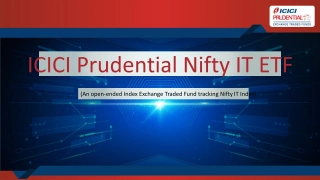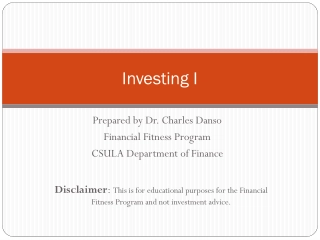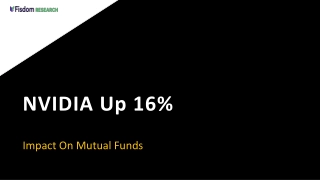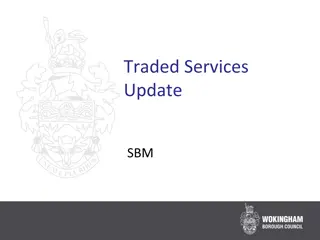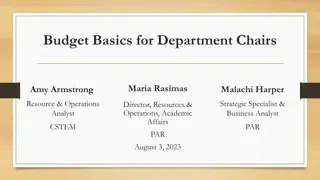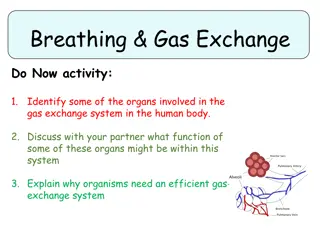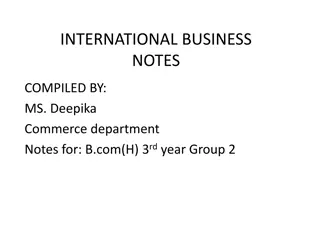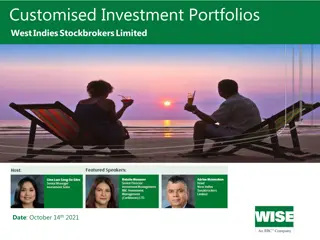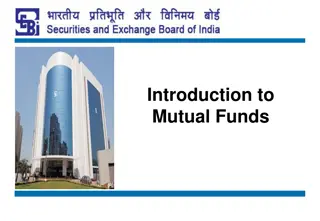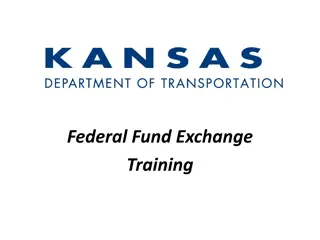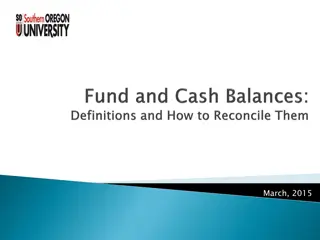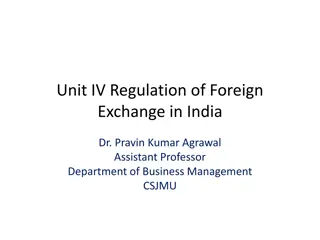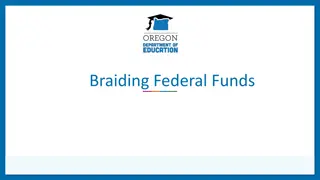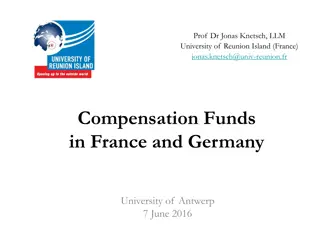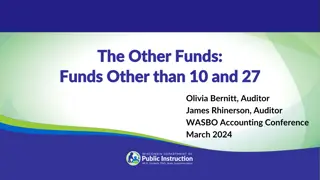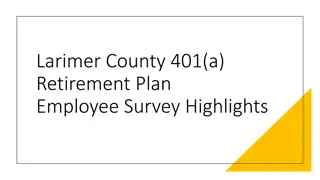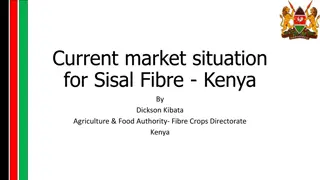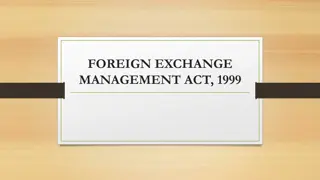Understanding Exchange Traded Funds (ETFs) - An Educational Overview
Explore the world of Exchange Traded Funds (ETFs) through an educational presentation covering what ETFs are, their advantages, differences from stocks and mutual funds, types, application procedures, investment processes, and more. Discover the operational aspects, investment styles, and objectives of ETFs in tracking benchmark indices for diversified exposure at a lower cost.
Download Presentation

Please find below an Image/Link to download the presentation.
The content on the website is provided AS IS for your information and personal use only. It may not be sold, licensed, or shared on other websites without obtaining consent from the author. Download presentation by click this link. If you encounter any issues during the download, it is possible that the publisher has removed the file from their server.
E N D
Presentation Transcript
Introduction to Exchange Traded Funds (ETFs)
Disclaimer Disclaimer Information contained in this presentation is as on May 09, 2022. The information contained in this presentation is only for Educational and Awareness Purposes related to securities market . This presentation is only for Educational and Investor Awareness Programs and shall not be used for any legal interpretations. SEBI or Stock Exchanges or Depositories shall not be responsible for any damage or loss to any one of any manner from use of this material. Suggestions or feedbacks, if any, may please be sent by mail to visitsebi@sebi.gov.in. 2
Flow of Presentation Flow of Presentation 1. What are ETFs? - Overview; 2. Advantages of investing in ETFs; 3. Difference between ETFs, Stocks & MFs; 4. Types of ETFs; 5. How to apply for ETFs during NFO; 6. How to invest in ETFs at SEs (Post closure of NFO); 7. iNAV and Market / Traded price of ETF; 8. Redemption of ETF units by AMC; 9. Buying ETFs directly from AMC (Bulk deal); 10. Tax on ETF Trades, etc.; 11. Points to ponder before investing. 3
What are ETFs? Overview SHARES SHARES EXCHANGE TRADED FUND (ETF) EXCHANGE TRADED FUND (ETF) MUTUAL FUND MUTUAL FUND ETF are like diversified mutual funds that are listed and traded on the stock exchange Operationally are like Mutual Fund Trade like Shares 4
What are ETFs? Overview Funds collected by ETF are invested in securities (debt/equity)/assets (gold/silver) which forms part of an Index/Asset Class. ETFs try to follow or replicate the performance of benchmark index Objective of ETF is to track the returns of a particular Index, viz. Nifty 50 or Sensex 30, It will invest in the securities which are part of Nifty 50 or Sensex 30 in the same proportion as that of the index. Holder of ETF units gets exposure similar to that of buying shares of the Index Thereby ETF holder gets benefits of diversification at a lower cost. 5
What are ETFs? Overview Investment style of ETF units is called Passive Investing. What is Active Investing Vs. Passive Investing. Active Investing - Fund manager invest and tracks returns of the selected securities (Stock picking based on analysis and judgement). Main purpose of fund is to beat benchmark index. To get Alfa Returns (i.e. To get returns above benchmark index). Rely on professional fund managers who manage investments. Passive Investing - Fund manager invest in the securities which are part of Index (No stock picking). Main aim of fund is to replicate or follow the returns of Index by making investment in the same proportion as that of the index. To replicate the return of the benchmark index by minimizing the tracking error. No Active fund management required. 6
Investing in ETFs Like a stock Like a fund Trading flexibility intraday on the Constructed to track an index exchange Open ended mutual fund Real time price Lower expense ratio generally Put limit orders as compared to an active fund Minimum trading lot is just 1 unit Lower turnover Delivery into your Demat account More transparent Index Fund Stocks ETF 7
Advantages of ETFs Investors in ETFs can benefit both the flexibility of a stock as well as the diversification 8
Difference between ETFs, Stocks & Mutual Funds Functionality ETFs Stocks MF Units Real time trading & pricing throughout market hours Can be purchased through brokers and /or online trading a/c Can be traded real time on the Exchange platform Is Diversification possible with a single unit Returns at par with the market / Index (subject to applicable fees and expenses) Paper less investing Exit Load 9
Types of ETFs Equity / Index ETFs Gold / Silver ETFs Global Equity ETFs Debt ETFs 10
Equity ETFs Equity ETFs are exchange-traded funds that seek to replicate and track a benchmark index like SENSEX, NIFTY, etc., as closely as possible; Equity ETFs offers instant diversification in a tax efficient and cost effective investment. The price fluctuations in Equity ETFs are directly linked to the index it follows, Equity ETF returns are not exactly the same as the benchmark index due to tracking error. Tacking error is the annualized standard deviation of the difference in daily returns between the underlying Index/goods and the NAV of the ETF calculated on a rolling basis. The Lower the tracking error means, more is the accurate replicating of the index . 11
Gold ETFs Gold ETF aims to track the physical gold price. Gold ETFs are units representing physical gold. Gold ETFs Having flexibility of stock investment and the simplicity of gold investments. Buying an Gold ETFs means an Investor is purchasing Gold in an electronic form. 12
Debt ETFs & Global Equity ETFs Debt ETF - Debt ETFs invest according to specific Debt Index. Debt ETFs also tracks different fixed income securities depending on an underlying fixed income index like Nifty 8-13 years G-Sec Index or NIFTY 4-8 years G-Sec Index. Global Equity ETF - Allow the investors to take an exposure to international indices. 13
How to invest in ETFs? Investor need to have three accounts Trading Account with Brokers Demat Account with DPs Bank Account 14
How to invest in ETFs? On going offer On going offer NFO NFO Buy/Sell Investor Stock Exchanges Buy/Sell Subscription 15
How to invest in ETFs During New Fund Offer (NFO) - 500/- or such other minimum amount Post Closure of Fund Offer, Ongoing Basis - On the Exchange : 1 Unit & in multiples thereof Directly with Fund : Large investors can directly purchase the units from the AMC in stead of buying from exchange 16
How to apply for ETFs-during NFO How to Apply: ETF Units available only in dematerialized (electronic) mode. Beneficiary account with a Depository Participant of NSDL/CDSL. Following details to be indicated in the application form : Depository Participant s name, Depository Participant s ID Number, Beneficiary account number of the applicant with DP. 17
How to apply for ETFs-during NFO Allotment: Intimation of allotment sent within five days from date of allotment. ETF Units are credited in DP account. Listing: Listing of ETF units on the Stock Exchanges. within 5 working days from the date of allotment. 18
How to invest in ETFs at Stock Exchange (Post close of NFO) Buy / Sell ETF units at stock exchange - Similar to buy / sell of shares in Secondary market. Investor need to place buy / sell order with stock broker. Investors can buy or sell at stock exchange post listing of ETF units . Minimum number of units for buy / sell : 1 (one) unit. Settlement of trades in ETF - Buying of ETF units - o Payment of funds before the funds pay-in day of the settlement cycle. o ETF units get credited in investor s demat account after pay-out day. Selling of ETF units - o Delivery of ETF units to broker before securities pay-in day. o Payment gets credited in investor s bank account after pay-out day. 19
iNAV and Market /Traded price of ETF Net Asset Value (NAV) of ETF - Value of each unit of ETF calculated by AMC of ETF. Market Price / Traded price of ETF - Price at which ETF units brought / sold at stock exchange. Price of ETF changes, based on market demand or supply of ETF. o Price increase, if there are more buyers of ETF. o Price decrease, if there are more sellers of ETF. Market price is premium / discount if traded price is more /less than NAV. What is iNAV (Indicative NAV) iNAV reported every 10-15 sec on the website of MF AMC during market hours. Currently, iNAV for Gols and Silver ETFs are also available on Exchange Platform. Before buying or selling decision, check iNAV of ETF units. 20
iNAV and Market /Traded price of ETF Real Time Pricing Live Quotes on Exchange site Real Time NAV on AMC site 21
Redemption of ETF Units by AMC In Normal case, Investor need to sell ETF units at Exchange through trading account. However, investors can directly approach AMC for redemption of ETF units, subject to the following conditions: a) Traded price of the ETF units - is at discount of more than 3% to NAV for continuous 30 days. a) Bid price quoted at exchange - is at discount of more than 3% NAV for 7 consecutive days. No quotes are available on exchange for 3 consecutive trading days. Total bid size on the Exchange is less than half of Creation Units Size daily, averaged over a period of 7 consecutive trading days. 22
Buying ETFs directly from AMC (Bulk deal) Applicable to Investors having large funds: Investors willing to buy ETFs in bulk may deal with AMCs directly. This facility is not suitable for small investors. Creation of ETF units is defined for every ETF and displayed on the AMC website. Creation Unit is a fixed number of ETF units, which is exchanged for a basket of shares underlying the index called the "Portfolio Deposit" and a "Cash Component". For e.g. to subscribe 10,000 units of an ETF with the Fund. Investor need to deposit a pre-defined underlying portfolio and the cash component. In exchange of this portfolio and payment of a "cash component", Investor is allotted 10,000 units. This "in-kind" exchange of underlying portfolio for units is a unique feature of ETFs. 23
Tax on ETF Trades Tax Structure on Capital Gains on Equity ETFs: Short-term capital gains are taxed at 15% along with surcharge and other Cesses as applicable. For all long-term capital gains, an amount of up to 1 lakh is tax- deductible, and a tax of 10% would be levied on any amount greater than 1 lakh without indexation benefits. Tax Structure on Capital Gains on Gold, Debt and Other ETFs: Long-term capital gains tax of 20% plus cess with indexation benefits, if held for more than 36 months. Short-term capital gains tax: As per the income-tax slab rate of the investor. Securities transaction tax (STT): If you buy ETFs there is no securities transaction tax (STT), but when you sell then STT is applicable. 24
Points to Ponder before investing Underlying Index: Investors need to first decide on the market in which they wish to invest, i.e. Benchmark Index as a whole or a Specific Sectoral Index Gold/ Silver, etc. iNAV: Before buying or selling decision, check iNAV of ETF units. 1 Total Expense Ration (TER): Different funds tracking the same index can have different expense ratios (annual fee a fund charges to cover its expenses). 3 Tracking Error : ETFs must closely track the benchmark. An ETF with lower tracking error to its benchmark preferred to others. 2 should be Liquidity: When considering ETFs, other than TER and Tracking Error, liquidity is also very important. One should prefer ETFs with greater liquidity. Assets Under Management (AUM) of an ETF is calculated by multiplying the shares outstanding by the market price per share. ETFs with greater AUM tend to have more liquidity. 25
26 Additional Information Additional Information For further information, you may visit the following web-sites and Mobile App: www.sebi.gov.in/ https://investor.sebi.gov.in/ Saa Saa thi thi App App For Grievance Redressal, you may visit following website: www.scores.gov.in/ Or, you may call SEBI at following Toll-free Helpline Numbers from 9:00am to 6:00pm on all days (excluding declared holidays in the state of Maharashtra): 1800 266 7575 1800 22 7575 SEBI : HAR INVESTOR KI TAAQAT Helplines are available in 8 Languages: English, Hindi, Bengali, Gujarati, Marathi, Kannada, Telugu and Tamil 26
THANK YOU 27


